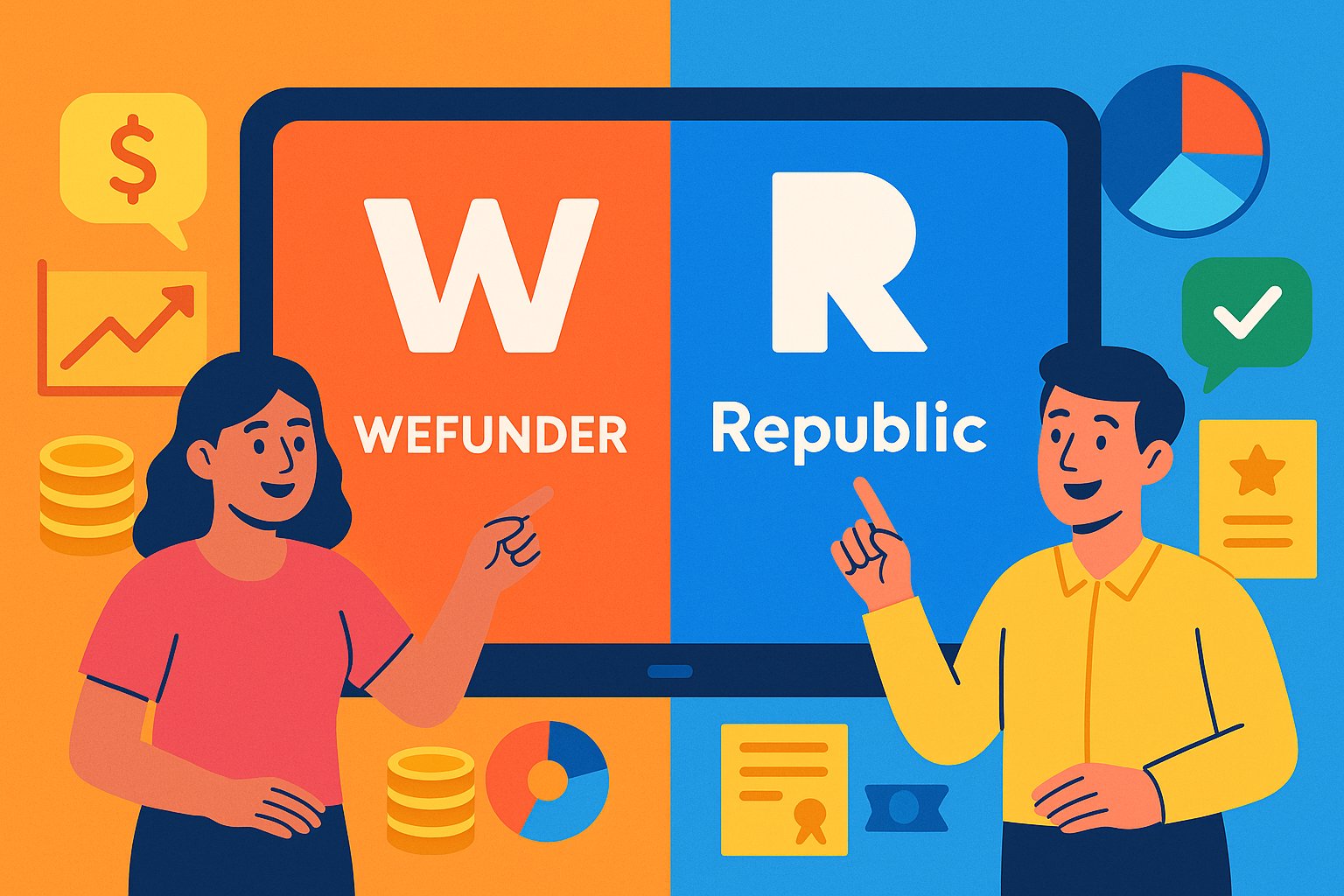Setting the Stage: Navigating the Equity Crowdfunding Landscape
Equity crowdfunding has revolutionized the way startups secure capital, tearing down walls that once separated founders from investors. No longer confined to venture capital backrooms or angel investor networks, today’s entrepreneurs can tap into vibrant online communities brimming with micro-investors eager to support innovative ideas. Two platforms, Wefunder and Republic, stand out as titans in this democratized fundraising arena. While both prioritize accessibility, transparency, and compliance, their approaches diverge in key areas—from fee structures and investor demographics to support models and technological capabilities. Understanding these distinctions is essential if you aim to maximize your campaign’s impact, minimize friction, and cultivate the right kind of backers. In the sections that follow, we’ll unpack the top differences between Wefunder and Republic, offering you a detailed roadmap to choose the platform that aligns with your strategic goals and growth trajectory.
Origins and Philosophies: Community-Driven vs. “Learn as You Go”
Wefunder burst onto the scene in 2012, fueled by a mission to empower entrepreneurs and everyday investors alike. It positions itself as a community hub where backers rally around startups not only for financial returns but for shared passion and mission-driven impact. Wefunder’s narrative emphasizes collective ownership, featuring regular “story highlights” and founder spotlights that humanize campaigns and amplify grassroots momentum.
Republic, launched in 2016, takes a slightly different tack. While also championing democratized access, Republic leans heavily into educational resources and co-investment vehicles. Its platform is designed to walk first-time founders and investors through every step, with “Republic University” webinars, investor bootcamps, and clear guidance on term sheets. This “learn as you go” ethos appeals to entrepreneurs who want a structured roadmap alongside their fundraising tools.
Fee Structures: Crunching the Numbers
When comparing costs, the devil is in the details. Wefunder’s pricing model centers on a 7.5% success fee applied to the total amount raised, plus a 2% escrow and processing fee. Founders face no upfront listing charges, but optional legal and compliance services—such as audited financials, SEC filings, and state Blue Sky registrations—come at an additional cost.
Republic differentiates itself with a 6% platform fee, slightly below Wefunder’s headline percentage, paired with a 2% payment processing fee managed by third-party processors. Republic also charges a nominal due-diligence fee upfront, usually credited back upon successful completion of your raise. Beyond these core fees, Republic offers add-on services—marketing support, investor relations tools, and back-office assistance—that can be purchased à la carte.
Target Investors: Micro-Backers vs. Aspiring Angels
Wefunder’s community comprises a broad spectrum of micro-investors, from passionate hobbyists to seasoned startup enthusiasts. The platform’s minimum investment amount is often as low as $100, inviting a high volume of small contributions that can quickly add up. This model transforms every backer into a potential brand ambassador, generating organic buzz as supporters share their enthusiasm across social media and personal networks.
Republic similarly promotes low-entry investments—often beginning at $50—but places extra emphasis on co-investment rounds. Through its partnerships with professional venture funds, Republic occasionally allows individuals to invest alongside institutional vehicles, a feature that can boost credibility and attract backers keen to “follow the lead” of seasoned investors. For founders seeking a balanced mix of “mom-and-pop investors” and emerging angels, Republic’s co-investment framework creates a unique value proposition.
Onboarding Experience: Self-Serve Tools vs. Guided Playbooks
Wefunder’s onboarding process combines intuitive self-service features with dedicated support channels. Founders gain access to a drag-and-drop campaign builder, social sharing widgets, and automated referral systems. Wefunder’s “Fellowship” program pairs campaigns with experienced mentors who’ve previously raised successfully on the platform, offering strategic feedback on pitch narratives and marketing tactics.
Republic doubles down on education. Its onboarding funnel includes mandatory walkthroughs of key legal documents, interactive tutorials on crafting investor decks, and live “office hours” where founders can ask seasoned operators for advice. This thorough hand-holding can lengthen the setup timeline but reduces missteps related to compliance or messaging. If you prefer a rapid DIY launch, Wefunder’s streamlined builder may resonate; if you value a step-by-step teaching approach, Republic’s playbooks provide structure.
Compliance and Legal Workflows: Turnkey vs. Modular
Navigating SEC regulations and state securities laws is a non-negotiable part of equity crowdfunding. Wefunder offers an optional “all-in-one” legal package, bundling Form C preparation, financial audits, and Blue Sky filings into one fee. Founders who lack in-house legal counsel appreciate this turnkey solution, which expedites the compliance process and reduces administrative headaches.
Republic, in contrast, opts for a modular legal approach. Founders can select belt-and-suspenders packages for disclosure documents, escrow services, and investor accreditation verification, mixing and matching based on their existing partnerships and budget. This flexibility enables cost savings for startups that already work with law firms or accounting teams but requires more hands-on coordination.
Marketing and Community Engagement: Viral Momentum vs. Educational Outreach
Wefunder’s marketing toolkit focuses on virality. Campaign pages feature built-in social proof modules—“I backed this” badges, share counters, and embedded testimonials—that encourage backers to spread the word. Wefunder’s editorial team regularly highlights trending campaigns in newsletters and blog posts, positioning successful raises as case studies to inspire other entrepreneurs.
Republic’s marketing support centers on education-driven outreach. The platform publishes in-depth guides, success playbooks, and data-driven trend reports that founders can leverage in pre-raise blogs and email sequences. Republic’s “Invest with Us” webinars connect founders directly with potential backers, allowing for live Q&A sessions that not only educate but also foster deeper relationships with investors who value transparency and learning.
Platform Technology: APIs and Integrations
In today’s data-centric world, the ability to integrate crowdfunding data into your existing systems can yield significant efficiencies. Wefunder offers a basic API that allows founders to embed progress bars and referral widgets into external websites. Dashboard analytics provide insight into total page visits, referral sources, and conversion rates.
Republic steps up with a more robust developer suite. Its API endpoints cover investor data exports, real-time transaction feeds, and event-triggered webhooks that can automate investor outreach via popular marketing automation platforms. For startups with in-house engineering resources, Republic’s deeper integrations enable custom investor portals, CRM syncs, and bespoke reporting that align seamlessly with internal workflows.
Investor Liquidity: Emerging Markets vs. Pioneering Platforms
Post-raise liquidity is becoming an increasingly attractive feature for backers worried about the long-term horizon of startups. Wefunder has begun piloting secondary trading opportunities, allowing investors to list and sell shares on a nascent marketplace. Although early-stage, this initiative adds an extra layer of appeal for risk-tolerant backers who want potential exit paths.
Republic’s secondary market, known as “Republic Raise,” is similarly in development but emphasizes compliance guardrails and KYC/AML controls. Its platform pairs with broker-dealers to ensure that secondary transactions meet securities regulations. For founders, these emerging liquidity avenues serve as powerful incentives to attract sophisticated investors looking beyond the initial fundraising window.
Investor Relations Post-Close: Nurturing Long-Term Advocates
Raising funds is only the opening act; sustaining investor enthusiasm is crucial for future rounds and brand advocacy. Wefunder streamlines post-raise communication with a built-in updates module. Founders can schedule milestone announcements—product launches, partnerships, revenue achievements—that populate investors’ dashboards and trigger notification emails.
Republic enhances this with segmented outreach. Its platform tags investors based on factors like investment size, investment date, and lead-investor status, allowing founders to tailor updates to different cohorts. This targeted approach can deepen engagement by delivering relevant, personalized content—whether you’re sharing beta testing invitations with early backers or inviting institutional followers to strategic briefings.
Campaign Performance Metrics: Surface-Level vs. Deep Dive
Wefunder’s analytics center on campaign health indicators: total funds raised, number of unique investors, referral channel breakdowns, and time-to-threshold metrics. These high-level insights help founders gauge momentum and pivot promotional tactics quickly.
Republic provides a more granular performance dashboard. In addition to the core metrics, founders can analyze investor demographics—geography, net worth brackets, investment history—and track behavior flows through click maps and scroll heatmaps on campaign pages. For data-driven teams that thrive on continuous optimization, Republic’s deep analytics can be a game-changer.
Community Vibe: Passionate Advocates vs. Knowledge Seekers
Wefunder’s investor community is known for its infectious enthusiasm. Many backers view their contributions as personal missions, championing startups they believe in with social media posts, blog features, and offline word-of-mouth. This grassroots fervor can create a snowball effect, propelling campaigns past stretch goals and onto national headlines.
Republic’s audience, while equally engaged, skews toward knowledge seekers. Investors on Republic often cite access to educational resources and the ability to invest alongside professional funds as primary motivators. This community values transparency, learning, and collaboration, frequently participating in skill-share sessions and sector-focused roundtables hosted by the platform.
International Accessibility: Global Reach vs. U.S. Focus
Wefunder accommodates international investors through simplified KYC and accreditation verification processes, although some securities restrictions still apply based on jurisdiction. Its global ambitions are reflected in multilingual campaign pages and partnerships with overseas payment processors.
Republic, while also welcoming non-U.S. backers, maintains tighter controls on cross-border investments. The platform integrates specialized accreditation checks for investors in select countries and ensures compliance with regional securities laws. For founders seeking rapid global expansion, Wefunder’s broader international footprint may unlock additional pools of capital, whereas Republic’s measured approach prioritizes regulatory certainty.
Speed to Launch: Rapid Deployment vs. Thorough Vetting
If time is of the essence, Wefunder typically offers a quicker path to “go-live.” Its streamlined approval process—often completed within a week—caters to founders eager to capitalize on market momentum or timely product announcements.
Republic’s comprehensive vetting, which encompasses legal reviews, financial audits, and team background checks, can stretch pre-launch timelines to several weeks. While this delay requires patience, it often translates into greater investor confidence at launch, reducing the risk of mid-campaign compliance issues or investor skepticism.
Decision Blueprint: Aligning Platform Strengths with Your Vision
Ultimately, the choice between Wefunder and Republic hinges on your startup’s unique needs and strategic priorities. If you crave lightning-fast launch, grassroots momentum, and strong community evangelism, Wefunder’s platform and passionate backer base may be your ideal match. Conversely, if you value educational guidance, deep analytics, co-investment opportunities, and a more curated investor pool—even at the expense of a longer timeline—Republic’s robust ecosystem will serve you well.
As you evaluate these platforms, consider your internal bandwidth, fundraising targets, marketing strategy, and long-term capital roadmap. Aligning Wefunder’s community-centric dynamism or Republic’s education-driven rigor with your campaign objectives will position you to secure the right capital, cultivate engaged investors, and lay the groundwork for future success. Armed with this side-by-side comparison, you’re now ready to embark on a crowdfunding journey tailored to your startup’s vision and growth ambitions.




